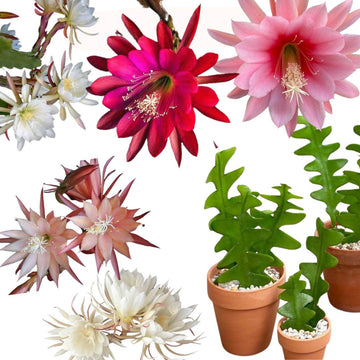
Summer is a season of warmth, sunshine, and outdoor activities. It’s the perfect time to go on adventures, relax in the sun, and enjoy all that nature has to offer. But what if you don't have the opportunity to spend much time outside? What if you want to bring some of that summer feeling indoors? One way to do that is by adding some plants to your living space. Here are the top 15 summer houseplants for indoor that will help bring the summer indoors and add a touch of natural beauty to your home.

Summer is the perfect time to brighten up your living space with some indoor plants. Here are 15 summer houseplants that will add natural beauty to your home and provide a variety of benefits.
-
Snake plant (Sansevieria trifasciata): A hardy plant that can thrive in a variety of light and temperature conditions, snake plants help purify the air and remove toxins like formaldehyde.
-
Spider plant (Chlorophytum comosum): Known for its easy-to-grow nature and air-purifying abilities, spider plants are perfect for hanging baskets and can thrive in a range of light and temperature conditions.
-
Peace lily (Spathiphyllum wallisii): A classic houseplant, peace lilies are known for their white, fragrant flowers and ability to purify the air by removing pollutants like benzene, formaldehyde, and trichloroethylene.
-
Rubber plant (Ficus elastica): With its glossy, deep green leaves, rubber plants can add a touch of elegance to any room. They also help purify the air and remove toxins like formaldehyde.
-
Bird of paradise (Strelitzia reginae): An exotic plant with vibrant, bird-like flowers, bird of paradise plants can add a tropical feel to any space. They also help purify the air and add humidity to dry rooms.
-
English ivy (Hedera helix): A fast-growing plant that can be trained to climb or trail, English ivy is a great air purifier and can help reduce mold in your home.
-
Boston fern (Nephrolepis exaltata): A classic fern with delicate fronds, Boston ferns can add a touch of lush greenery to any space. They also help purify the air and add humidity to dry rooms.
-
Aloe vera (Aloe barbadensis): Known for its healing properties and ability to soothe sunburns, aloe vera is also a low-maintenance plant that can add some natural beauty to your home.
-
Golden pothos (Epipremnum aureum): A hardy plant that can thrive in low light conditions, golden pothos are known for their ability to purify the air and remove toxins like formaldehyde.
-
ZZ plant (Zamioculcas zamiifolia): A low-maintenance plant that can thrive in a range of light conditions, ZZ plants are known for their ability to remove toxins from the air and add some natural beauty to your home.
-
Philodendron (Philodendron spp.): With its heart-shaped leaves and trailing vines, philodendrons can add a touch of elegance to any room. They also help purify the air and remove toxins like formaldehyde.
-
African violet (Saintpaulia spp.): Known for their colorful, delicate flowers, African violets are perfect for adding a pop of color to your living space. They also help purify the air and add humidity to dry rooms.
-
Croton (Codiaeum variegatum): With its vibrant, colorful leaves, croton plants can add a tropical feel to any space. They also help purify the air and remove toxins like formaldehyde.
-
Chinese evergreen (Aglaonema spp.): A low-maintenance plant that can thrive in low light conditions, Chinese evergreens are known for their air-purifying abilities and attractive foliage.
-
Rubber fig (Ficus elastica 'Burgundy'): A striking plant with deep burgundy leaves, rubber figs can add some dramatic flair to your living space. They also help purify the air and remove toxins like formaldehyde.
FAQs:
-
What are some benefits of having houseplants? Houseplants have numerous benefits for both mental and physical health. They help purify the air, boost productivity, reduce stress and anxiety, and improve overall mood. Additionally, houseplants are a great way to bring natural beauty into your home and add some color to your living space.
-
What are the best summer houseplants for indoor? The best summer houseplants for indoor are those that can thrive in bright light and warm temperatures. Some of the top options include the snake plant, spider plant, peace lily, rubber plant, and bird of paradise.
-
How often should I water my summer houseplants? The frequency of watering will depend on the specific plant, its size, and the conditions in your home. It’s important not to overwater, as this can lead to root rot. A good rule of thumb is to let the top inch of soil dry out before watering again.
-
Can I keep my summer houseplants outside? While some summer houseplants can thrive outdoors, it’s important to keep in mind that they may not be able to handle direct sunlight, wind, or extreme heat. Be sure to research the specific plant and its outdoor needs before moving it outside.
-
How do I know if my summer houseplants need fertilizer? Fertilizing can be beneficial for houseplants, but it’s important not to overdo it. Signs that a plant needs fertilizer include yellowing leaves, stunted growth, and a lack of new growth. If you notice these signs, it may be time to fertilize.
Conclusion: In summary, summer houseplants are a great way to bring some of the outdoors inside and add some natural beauty to your home. Whether you have a green thumb or are just starting out, there are plenty of options to choose from. By selecting the right plant for your space and following basic care guidelines, you can enjoy the beauty and benefits of summer houseplants all year round.




